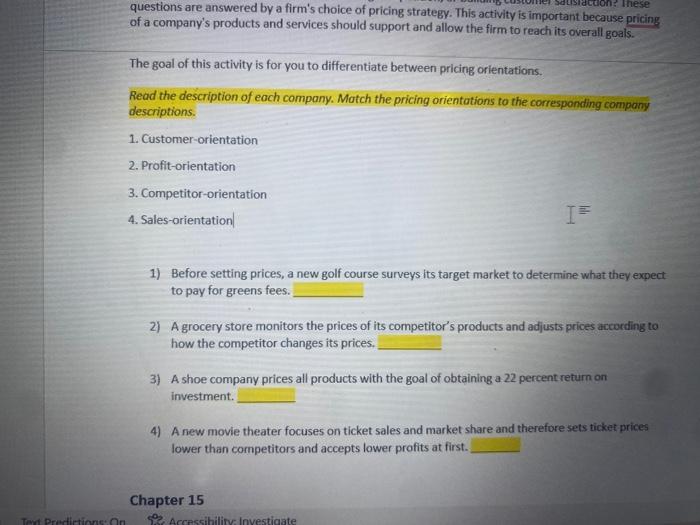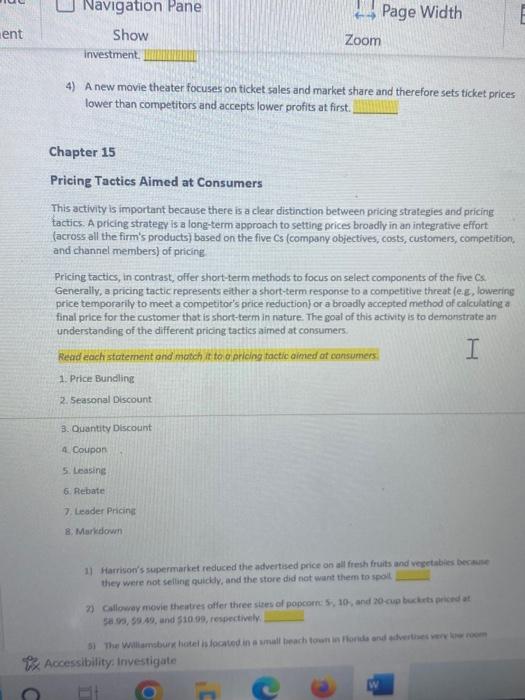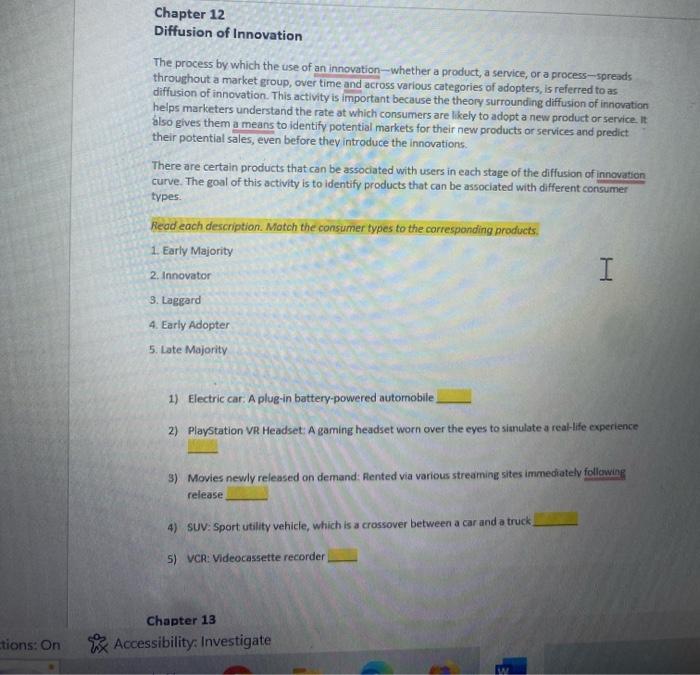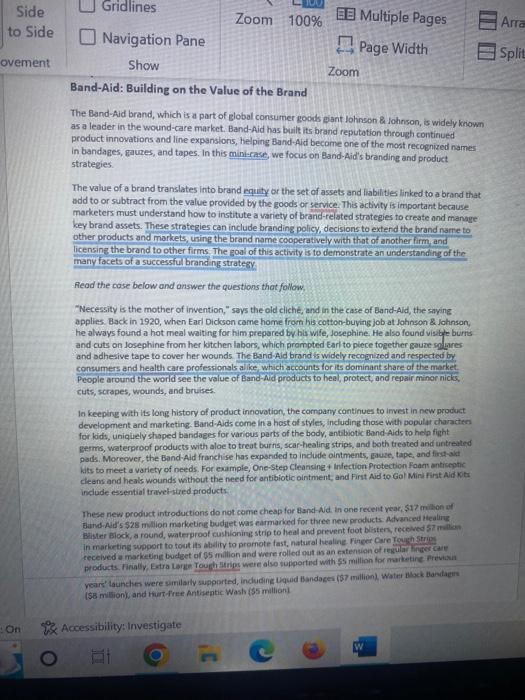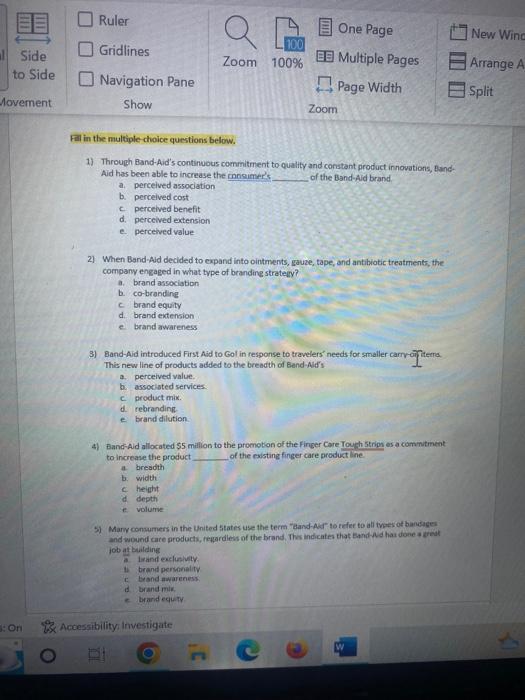questions are answered by a firm's choice of pricing strategy. This activity is important because pricing of a company's products and services should support and allow the firm to reach its overall goals. The goal of this activity is for you to differentiate between pricing orientations. Read the description of each company. Match the pricing orientations to the corresponding company descriptions. 1. Customer-orientation 2. Profit-orientation 3. Competitor-orientation 4. Sales-orientation| 1) Before setting prices, a new golf course surveys its target market to determine what they expect to pay for greens fees. 2) A grocery store monitors the prices of its competitor's products and adjusts prices according to how the competitor changes its prices. 3) A shoe company prices all products with the goal of obtaining a 22 percent return on investment. 4) A new movie theater focuses on ticket sales and market share and therefore sets ticket prices lower than competitors and accepts lower profits at first. 4) A new movie theater focuses on ticket sales and market share and therefore sets ticket prices lower than competitors and accepts lower profits at first. Chapter 15 Pricing Tactics Aimed at Consumers This activity is important because there is a clear distinction between pricing strategies and pricing tactic . A pricing strategy is a long-term approach to setting prices broadly in an integrative effort. (across all the firm's products) based on the flive Cs (company objectives, costs, customers, competition, and channel members) of pricing Pricing tactics, in contrast, offer short-term methods to focus on select components of the five Cs. Generally, a pricing tactic represents either a short-term response to a competitive threat (e.g, lowering price temporarily to meet a competitor's price reduction) or a broadly accepted method of calculating a final price for the customer that is short-term in nature. The goal of this activity is to demonstrate an understanding of the different pricing tactics aimed at consumers. Read each stotement ond motch it to opricing toctic aimed at cansumers: 1. Price Bunding 2. Seasonal Discount 3. Quantity Discount 4. Coupon 5. Leasing 6. Rebate 7. Leader Pricinet 8. Markidown 1) Harrison's supermarket reduced the advertised price on all fiesh fruits and vesetabies heceust they were not seliang quiddy, and the store did not want them to spoll 5 cors, 59.59, and 510.39, respertively: 1) Harrison's supermarket reduced the advertised price on att fresh fruits and vegetables because they were not selling quickly, and the store did not want them to spoil. 2) Calloway movie theatres offer three sizes of popcorn: 5-, 10-, and 20-cup buckets priced at. $8.99,$9.49, and $10.99, respectively. 3) The Williamsburg hotel isJacated. in a small beach town in Florida and advertises very low room prices from December to February. 4) Hartford food stores use these to induce their customers to try new products, convert first-time users to regular users, increase purchases, and protect market share. 5) Hemmings Tech, a manufacturer of dieital cameras, issues a refund as a porticn of the retaif purchase price of its newest camera. 6) Dorchester Outdoors, a huntine, boatine, and outdoor sporting eoods store, is offerine a new fishing boat for $299 a month for 36 months. At the end of the period, the customer will have to return the boat to the store. 7) Gateway Cable is offering high-speed internet, rable television and home phone senvice for $125 per month. If all were purchased separately, it would total $160 per month 8) Wilkerson supermarket agereswively prices its produce iterns io.ocder. to set more customers into the store 1) Electric car: A plug-in battery-powered automobile 2) Playstation VR Headset: A gaming headset worn over the eyes to simulate a reak-life experience 3) Movies newly released on demand: flented via various streaming sites immediately following release 4) SUV: Sport utility vehicle, which is a crossover between a car and a truck 5) VCR: Videocassette recorder Band-Aid: Building on the Value of the Brand The Band-Aid brand, which is a part of elobal consumer goods ejant lohnson \& lohnson, is widely known as a leader in the wound-care market. Band-Aid has built its brand reputation through continued product innovations and line expansions, helping Band-Ald become one of the most recognized names in bandages, gauzes, and tapes. In this mi ithrase, we focus on Hand-Aid's branding and product strategies. The value of a brand translates into brand equity or the set of assets and liabilities linked to a brand that add to or subtract from the value provided by the goods or service. This activity is important because marketers must understand how to institute a variety of brand-related strategies to create and manage: key brand assets. These strategies can include branding policy, decisions to extend the brand name to other products and markets, using the brand name cooperatively with that of another hirm, and licensing the brand to other firms. The goal of this activity is to demonstrate an understanding of the many facets of a successful brand ng strategy. Read the case below and answer the questions that follow. "Necessity is the mother of invention," says the old cliche, and In the case of Band-Aid, the saying applies. Back in 1920, when Earl Dickson came home from his cotton-buying job at Johnson \& Johnson, he always found a hot meal waiting for him prepared by his wife, Josephine He also found vis ge bums and cuts on Josephine from her kitchen labors, which prompted Earl to plece together gouze sollares and odhesive tape to cover her wounds. The Band Ald brand is widely recoenized and respected by, consumers and health care professionals alike which accounts for its dominant share of the market. People around the world see the value of Eand-Ned products to heel, protect, and repair minor nicks. cuts, scrapes, wounds, and bruises. In keeping with its long history of product innovation, the company continues to irvest in new product development and marketing. Band. Aids come in a host of styles, including those with popular characten for kids, uniquely shaped bandages for various parts of the body, antibiotic Band Aids to heip fight germs, weterpeoof products with aloe to treat burns, scar-healing strips, and both trested and untreated pods, Moreover, the Band-Aid franchise has expsnded to indude ointments, Eause, tape, and first-akt kits to meet a variety of needs. For example, One-step Cleaning + Infection Protection Foamt antiseetic cleans and heals wounds without the need for antibiotic ointment, and First Aid to Gol Mins First Ad Kit: indude essential travel-sued products. These new product introductions do not come cheap for tand- -id. in one recent yeac, \$17 milion of Barve. Aid's 5728 million marketice budilet was earmarked for three new products. Advanced itealire Brister Biock, a round, waterproof cushioniry, strip to heal and prevent foot bisten, receved 57 mallian in marketing woport to tost its abelity to promote fast, natural healine Finger Care rough 5 trips years' tauncher were similarty supported, induding Liquid Bandages (37 million) Water dock Basitagis (\$8 mition), and thur free Antisentic Wash (\$5 million) Ruler Gridlines Navigation Pane Show Zoom One Page Fill in the multiple-choice questions beforw. 1) Through Band-Aid's continuous commitment to quality and constant product in novations, Eand- Aid has been able to increase the rnnoimer's of the Band-Aid brand. a. perceived association b. perceived cost c. percetved benefit d. perceived extension e. percetved value 2) When Band-Aud decided to capand into ointments, gauze, tape, and antibiotic treatments, the company engaged in what type of branding strateiry? a. brand association b. co-branding c brand equity d. brand extension e. brand awareness 3) Band-Aid introduced First Aid to Gol in response to travelers' needs for maller carrvo if Teria. This new line of products added to the breadth of Band-Aid's a. perceived value. b. associated services. c. product mix. d. rebranding. e brand dilution. 4) Eand-Aid allocated $5 million to the promotion of the Finger Care Tough 5 trips es a camnitment to increase the product of the existing finger care product ine. a breadth b. width: c. height d. depth e. volutrie. 5) Mary consumers in the thited states use the term "Hand-Adt to refer to ali thes of barciges and wound care products, rewardiess of the brand, Thes indicates that Emidsd has done a dreal job a a brilding a Iranit exclusivity. 1. brand perseriality c. brand awareness: 15 brand mir, e brarid equity
